According to statistics, almost half of all appeals to a dermatologist are connected to mushroom diseases in one way or another. You can pick up the infection when you visit the pool, visit the sauna, visit the beach or have visited the masters' slippers.
Learn everything about how you can recognize the mushroom of nail fungus on the legs without a template and the use of other diagnostic methods - the symptoms of manifestations of onychomycosis of the initial and chronic stage of the disease.
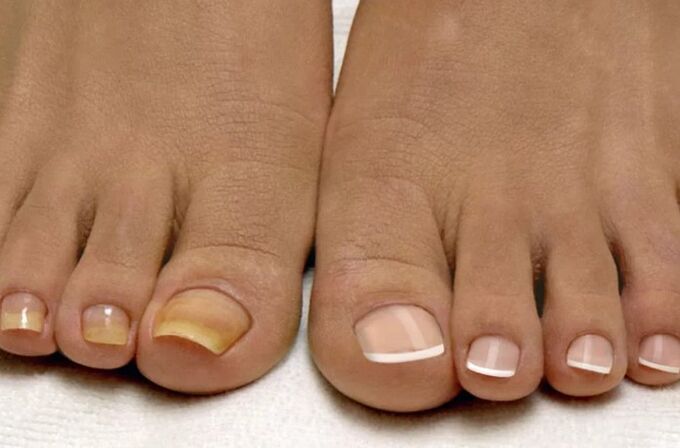
Many do not even suspect that the banal sweating of the legs, accompanied by an unpleasant smell that suffers more than half of the population of our planet, is one of the main symptoms of nail fungus. This disease is at risk of getting sick, which at least neglects a little personal hygiene.
The mushroom of nails are waiting everywhere, especially public use. And the worst thing is that nail fungus is a fairly insidious disease: the treatment is long and not always successful because mycosis is inclined to relapse.
In order to recognize the disease in good time and start your treatment, you should know all the signs of mushrooms on the legs.
How does the disease spread?
The infection is caused by parasitic fungi. An ideal environment for your reproduction and development is an increased humidity in combination with a warm atmosphere. It is generally recognized that the main places where the risk of infection with nail fungus is high is high, baths, saunas, water parks, pools, manicure salons, etc.
However, the statistics completely refute these statements: The nail fungus can be picked up at home by general things (towels, shoes, clothes, carpets, shower or bathroom) if one of the family members already or at a party, for example through slippers, kindly suggested by the owner (and he may not even earn the presence of an illness).
But what factors influence the development of a fungal disease? Such basic moments have been determined, which leads to infection with onychomycosis:
- Acceptance of immunity;
- Violation of the nail plate;
- Violation of blood circulation in the lower extremities that can occur when wearing close shoes;
- Pathologies of the feet of anatomical nature;
- Obesity;
- Diabetes mellitus;
- Increased sweating.
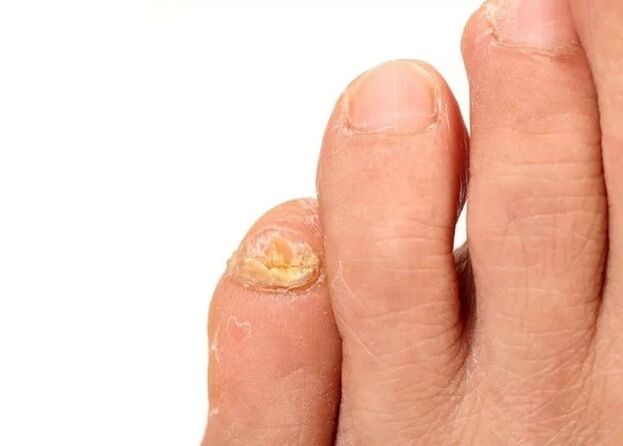
To protect yourself at least partially, you should only use your things, carefully treat the bathroom and shower with antiseptics, use a personal towel, regularly the carpets, disinfected shoes, clean and wash. And in order not to miss the moment that is favorable for the treatment of mycosis (after all, everyone knows that the therapy in the early stages of the development of the disease is most effective), you must know the first signs of nail fungus.
After you have recognized the first signs of nail fungus, you should immediately contact a specialist who prescribes the optimal treatment scheme.
How do different types of onychomycosis manifest?
3 types of onychomycosis are determined, each of which manifests themselves in their own signs.
You can determine the presence of a mushroom on the nails yourself, but only a specialist can specify a precise diagnosis. To do this, you need to visit the clinic to analyze scratching a painful nail or skin that is around you. In addition, a dermatologist prescribes a microscopic or cultural study.
Signs of mushroom through pathogens of the disease
The success of the treatment of nail fungus depends on how correctly the pathogen is diagnosed. This is explained by the fact that the disease does not cause a kind of mushrooms, but several and that each of them is sensitive to certain medication. This means that if a kind of fungus is resistant to a medication, the other pathogen dies of this product.
More often, nail fungus caused:
- Yeast;
- Dermatophytes;
- Mold.
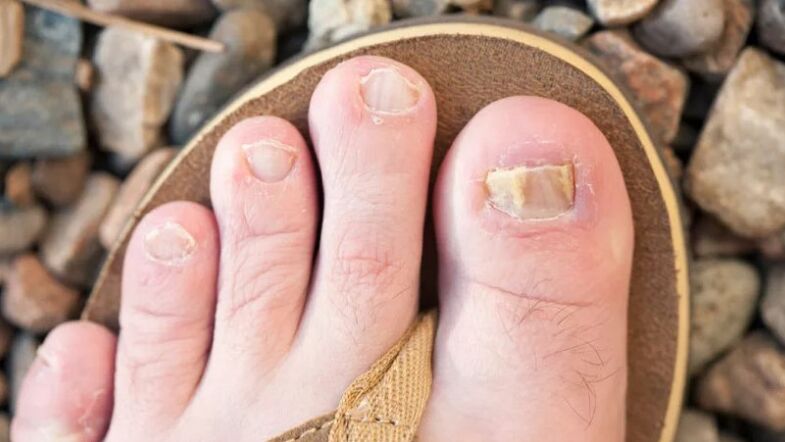
If the cause of the nail fungus has become Hese, it is almost impossible to identify the disease immediately. Signs of mushrooms on the legs of the legs in this case are the following (they appear after a long time): peeling the nail plate and light itching of the skin near the nail (itching can be missing). An error infection with yeast occurs in 4-4, 5% of cases.
Dermatophytes influence the nails of a person much more often than the previous pathogen - this is 94, 5% of all cases of infections of nails with a fungus. Dermatophytes are of three types, each manifested in different ways:
The last type of mushroom is mold. His pathogen is forms. This disease is found in only 1% of cases. A fungus of this kind develops more often in HIV-infected people.
Other symptoms of a mushroom nail infection
At the beginning of the illness, there are often obvious signs of mushroom nail damage. To be careful, however, you can notice some changes in the structure of the nail and its appearance.
As already mentioned, longitudinal or round white spots can appear on the nail plate on the nail plate. The nail can become wave -like while its smoothness and brilliance are lost.
Progress, the disease is increasingly destroying the nail plate: first its shadows change, then the surface of the nail becomes scaly, it thickens or thickens, relaxes, breaks. The color of the nail depends on the type of fungus the causal means of infection.
In addition to the main signs of onychomycosis, there are others:
- the fragility of the edges of the nail plate or its entire surface;
- Disturbing of the shape of the nail, scaly structure of its structure;
- Blacation of the nail;
- Cut nails under the skin;
- Dysbiosis, drowsiness, general weakness;
- Removing the plate from the nail bed, which leads to the formation of a badge under the nail of a whitish or yellow shadow with an unpleasant smell;
- Itching, crack, burning the skin in the immediate vicinity of the affected nail;
- Dysbiosis, drowsiness, general weakness.
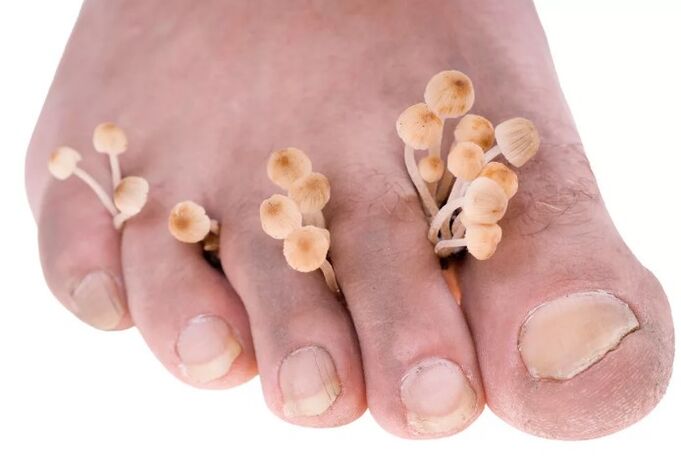
Any deviation of the appearance of the nails on the legs should be vigilant, as this can indicate the development of nail fungi. The first action in this case is a journey to a dermatologist who confirms or refutes its fears. If this is not done immediately, the disease will progress.
At first glance, there is nothing wrong with this disease. In addition to purely aesthetic problems and symptoms, the mushroom can cause serious complications to the purulent infection of the affected areas and even the development of gangrene.
Therefore, do not tighten with the treatment and take measures at the same time as soon as the disease has been recognized.
What does the nail funga look like?
Every third person on earth met with a problem such as layering and crumbs of nails, the cloudy of the plate - this is onychomycosis. The disease affects different age groups. The mushroom of nails on the legs (photos are shown below), spreads quickly and adapts to new conditions. We will consider the main factors for the appearance, the types and methods for the treatment of the mushroom in more detail.
What is nail fungus?
Onychomycosis is a pathology that destroys the nail plates. The mushroom eats keratin - the building basis of the nail. The infection falls into the intercellular space and begins its division. In the advanced stages, pathology can influence the skin of the feet, the interal zone and paragraphs.
Don't start the mushroom and treat it immediately
Causes of nail fungus
Infected with onychomycosis is pretty simple. The infection can lurk at the pool on the beach, in the public soul. A high probability of catching a fungus of infected relatives or acquaintances (using common life).
There are several main requirements that can provoke the penetration of the virus into the human body:
- A weak immune system - a decrease in the protective forces due to contagious or inflammatory diseases;
- Vascular pathologies (blockage of the veins) violations of the work of internal organs (diabetes) that lead to problems with the blood flow to the lower extremities;
- Minor damage to the skin on the feet (abrasions, microesses, grains, grains) that were caused by wearing close shoes;
- Ignoring diaper rash and intensive sweating of the lower extremities;
- Violation of the precautionary measures - trying on another, attempting to visit public places without slippers and neglect the hygiene of the legs.
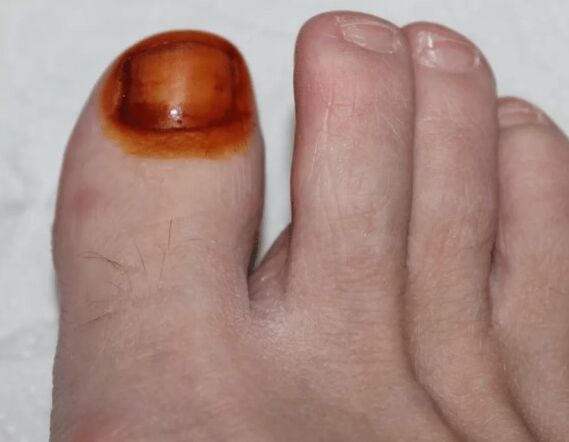
Types of nail fungus
Onychomycosis can provoke different types of mushrooms. Dermatophytes appear, for example, in the form of clouding the nail. There is a formation of yellow spots along the edges or in the middle of the plate. In addition, longitudinal sections along the affected area can be observed.
Surgical intervention may be necessary in the late stages of nail fungus
The yeast mushroom provokes a deformation of the nail plate. It is very clever and begins to move away from her place becomes gray. The metabolism in injured cells worsens, furrows appear on the nail roller. In addition, inflammation, edema and redness appear on the adjacent epidermis, the disappearance of the cuticle is observed.
Mold mushroom bacteria can violate the nail plate if there are already diseases that cause nail nutritional disorders. In this case there is also a cloudy of the plate, a change in its color (from light yellow and greenish to brown and even black).
In order to find out the cause and the pathogens of negative changes in skin and nails, you must contact a specialist. An independent determination of the disease and its treatment without consulting a doctor can be affected with consequences.
Folk methods
There are no traditional active ingredients against fungal infections at an early stage of development. The following is most effective:
- Apply iodine on the nail plates hit by a mushroom every day and before going to bed until the symptoms have disappeared completely.
- Mix 3 tablespoons of water with a teaspoon of glycerin, vinegar and iodine. The composition of the nails for 10 days;
- Mix 9% vinegar with water in a part of 1 to 8. Better your legs in the resulting liquid for 20 minutes. The procedures are repeated every other day. A total of 7-10 of them should be;
- Place a raw egg in the container and pour 9% vinegar. After the shell is completely dissolved, remove the rest of the film and mix the vinegar with the egg. The solution is treated with nails twice a day for 3 weeks.
- 4 dissolve hydrogen peroxide in 2 liters of water. Keep your feet in the container and hold it for 20 minutes. The course of treatment is 10 days;
- To moisturize a cotton smear in peroxide, attach it to the nail, which is affected by a fungal infection. Before the procedure, the legs in a bathroom should be steamed with soda. The compress is packed with cellophane above. Hold an hour. The therapy lasts 2 weeks;
- Moisten a cotton pad in 20% alcohol tincture from propolis and attach it to an infected nail. Keep the compress until they are completely dry. The procedure is carried out twice a day. The treatment continues until the symptoms of the disease have completely disappeared.
- Clean the clove of garlic and cut it into the floors. Get wet in salt and rub your nail thoroughly. Processes that have to be carried out twice a day until the features of the mushroom have completely disappeared.
- Add 2 teaspoons of ammonia to a glass of water. In the solution you moisten a cotton block, apply it to the nails affected by the mushroom and leave it overnight. The course of the therapy is 7 days;
- Grind the onion thoroughly until the porridge is formed. Apply the product to infected nail plates for half an hour. Treatment takes place daily until full recovery;
- Mint mint, sage and chamomile in the same proportions. Pour medical plants in the toes and put them in the night. Grass has to be changed into freshness every day. The tool is used as a supplement to other methods.
- Take tea tree oil and Celandine in the same quantities. To be able to soak a cotton swab, put it on an infected nail for 45 minutes. The course of treatment is 20 days. The tool is not permitted during pregnancy.
- In 500 ml of water you brew 6 teaspoons of nettle leaves. Place them on the nail plates in a decoction with a moisture cotton wool with onychomycosis. Continue the treatment until the symptoms have completely disappeared.
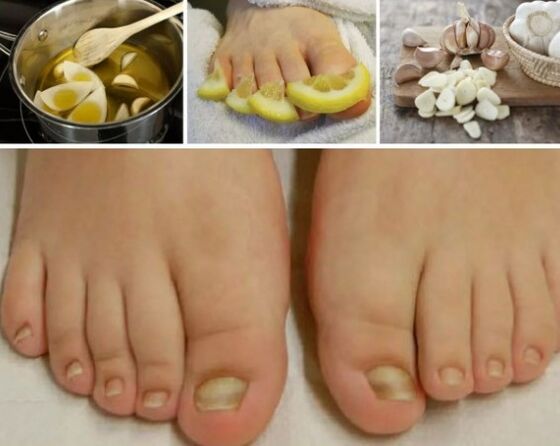
All folk remedies can only be used after consultation with a dermatologist. Many of them are able to provoke allergic reactions. It is easier to heal onychomycosis by not combining traditional medication with medication.
In the initial phase, the mushroom looks like almost invisible grooves or white spots on the legs. Often a person only learns from a dermatologist from the presence of a fungal infection during a visit. This is due to the fact that it is almost impossible to recognize the disease during this period. If you start the therapy in time, the disease will be healed quickly.


















